Capture Every Moment: The Best Dash Cams of 2024, Reviewed
Best Dash Cams of 2024Gear Team - Car and Driver "Hearst Magazines and Yahoo may earn commission or revenue on some items through these links." As anyone knows who enjoys a good crash compilation on YouTube, anything can happen while you're on the road.
It's best to be prepared, and a dash cam is a fantastic way to capture evidence (or a good story for the bar on Saturday night). But like anything techy, there are way too many options to choose from. Should you get one with a screen?
How about an interior camera? Do you need extra functions like vehicle speed and GPS locating? How well do they do at night?
And what's the deal with legality and insurance on these things? We at the Gear Team aimed to answer these questions and more with this comparison test. We ran a selection of top dash cams through a set of exacting testing parameters to separate the decent from the great.
Here's everything you need to know about choosing the best dash cam for your vehicle. Here are our picks for the Best Dash Cams of 2024. (For the best visual comparison, make sure to turn the quality up on the YouTube videos.)
What to Consider When Purchasing a Dash Cam
Dash cameras come in all shapes and sizes and at price points from sub-£50 to well over £500. Deciding why you want a dash cam, what features you need, and how much you want to spend will determine which dash cam you should buy.
Before you decide to pony up for a pricey dash cam--or, conversely, a less expensive model without all the bells and whistles--there are a ton of important factors to consider.
Storage
Here's the Dirty Little Secret about dash cams: Many are worthless right out of the box. After all, what good is a dash cam if you can't provide its footage to investigators later (or upload it to YouTube or CrashDashes[1])? Dash cams are generally too small to feature internal storage, so they require some sort of external memory, such as a micro SD card, to save footage.
Problem is, most don't come with said memory card included; you need to buy it separately or upgrade to a bundle that includes one. Always check to see if the model you're considering requires and comes with a memory card, and purchase one if necessary so you can use the dash cam right away. Story continues
Pro tip: Since most card-based dash cams typically overwrite older footage when storage capacity is reached, we recommend purchasing a high-capacity memory card anyway to safeguard against accidental deletion. On the flip side, many modern dash cams utilize cloud storage, which uploads data to a server for remote storage. Cloud-based dashboard cameras generally require an additional subscription cost and connection to a smartphone or Wi-Fi signal at varying intervals, but eliminate the need for memory cards[2] and allow access to footage at any time, as long as your subscription is active.
Resolution and Quality
A dash camera's quality significantly affects the ability to retrieve detailed information later.
Image quality hinges on sensor size, dynamic range, lens material and design, and image processing. If you'd like to read a more detailed breakdown of how these elements impact image quality and what you should look for to get the best image possible, we break it down with an in-depth analysis below.
Features
Newer dash cams often come loaded with additional features like GPS, emergency service alerts, and radar detectors. More features usually come with a higher price tag; bundling optional features such as interior cabin cameras can be a more practical approach to "all the bells and whistles."
However, the modern gadgets that many of us own and use, such as phones and radar detectors, already offer some of these features. There are also some really good built-in systems, such as those from Tesla or Rivian, which might render dash cams obsolete in just a few years. Decide what you need from a dash cam before you buy one.
Safety Features
If you drive an older car, consider a dash cam loaded with integrated safety features, such as those often found standard in new vehicles.
For instance, Garmin[3] dash cams offer lane-departure warnings, while some Nextbase[4] models can automatically call for help in case of an accident.
How We Tested Dash Cams
The Gear Team strived to keep this test as objective as possible by comparing specs and video recordings side by side. But subjective things matter too. We took notes on the usability of the cameras themselves, along with any companion apps.
Additionally, we noted other random tidbits that we felt impacted the overall results. Here are the parameters we tested for:
Resolution
Field of view
Clarity in various conditions (sunshine/overcast/night)
License-plate clarity at various distances (5, 10, 25, and 50 feet)
Installation
Usability (including app, if applicable)
Quality-of-life notes
Vantrue N4 3
The Vantrue N4 3 is an exceptional value, offering a dash cam, cabin-facing camera, and rearview camera. It attaches to the windshield with a suction mount, and its cameras can be adjusted for optimal coverage.
The front dash cam records at 2560 by 2160 pixels but drops to 2560 by 1440 when all three cameras are used. The cabin and rear cameras have 1920 by 1080 resolution. The cameras have wide fields of view with minimal distortion, and the cabin camera includes infrared lighting for low-light conditions.
The N4's integrated screen features a picture-in-picture mode that displays all three cameras' feeds simultaneously, along with settings and recording modes. It offers low-frame-rate and low-bit-rate recording modes, but we found these can drain the car battery. The device also includes collision and motion detection, automatically saving relevant footage.
A 128 GB micro SD card holds about 6.7 hours of footage. We picked the Vantrue N4 as our Best Overall dash cam mainly because of its value. It's a strong competitor at a great price, with three cameras and lots of features, and it came in only slightly behind our top pick in image quality.
Video quality was impressive across various light conditions, with good dynamic range and minimal noise reduction.
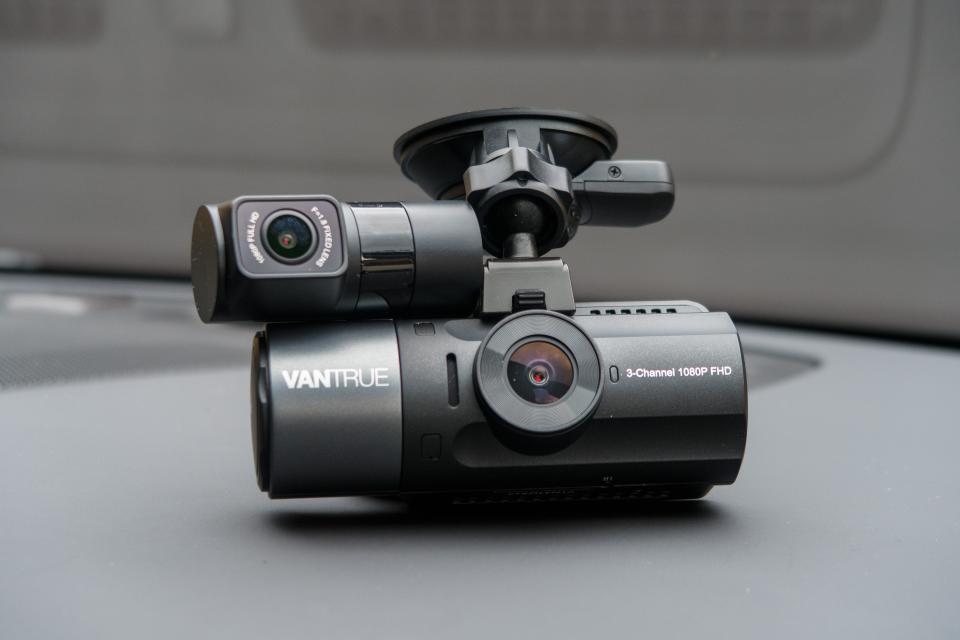
amazon.com £259.99
Gannon Burgett - Car and DriverLicense Plate at 5 (top left), 10 (top right), 25 (bottom left), 50 feet (bottom right)


Vantrue N4 3 Sample Footage
See the original post on Youtube[6]
[embedded content]
Cobra SC 400D
As far as pure visual performance, the Cobra SC 400D was the best dash cam we tested thanks to its 4K resolution. We agreed that its video footage genuinely looked the best too. We found the touchscreen to be easy to operate and responsive, and the Cobra uses its proprietary DriveSmarter app to provide police alerts and other driver reports.
If we had one minor grumble, it would be that the mount only swivels forward and backward, not side to side. However, the wide angle of the lens practically eliminates the need to do so. The Cobra secures to the windshield via a large sticky pad for the mount and a very strong magnet for the camera itself.
Of course, this kind of quality and transparent amount of features add up in cost, but if you're serious about purchasing a dash cam, we loved this one.

amazon.com £353.54
Gannon Burgett - Car and DriverLicense Plate at 5 (top left), 10 (top right), 25 (bottom left), 50 feet (bottom right)


Cobra SC 400D Sample Footage
See the original post on Youtube[8]
[embedded content]
Dual View
We appreciate that we'll probably get some flak for including this model in this test when there are so many dash cams out there. But we were determined to evaluate our (licensed) namesake unit on its own merits--and darned if it didn't step up as the best budget option we tested. The Car and Driver Dual View model has front and rear cameras and a touchscreen interface for easy driver control.
The unit has standard features like parking mode, collision detection, and a G sensor to keep one eye open after you've left the vehicle. One thing we really liked about this model is its dual tripod option that allows different mounting iterations from the top or bottom of the camera. This feature made it easy to adjust the dash cam according to the angle of the windshield.
During our driving test, we detected a faint magenta hue on the screen, which we could not adjust for. But when we uploaded the data, the magenta hue did not affect the footage. This budget-friendly dual camera covers all the essential features and has adjustable orientations.
It's an excellent choice for dash-cam beginners.
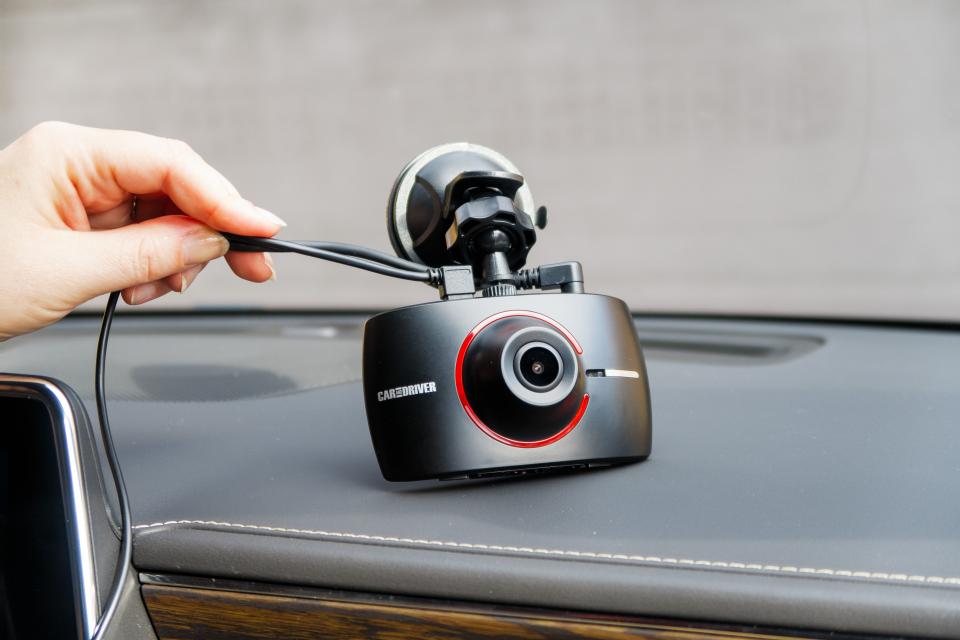
amazon.com £139.99
Gannon Burgett - Car and DriverLicense Plate at 5 (top left), 10 (top right), 25 (bottom left), 50 feet (bottom right)


Car and Driver Sample Footage
See the original post on Youtube[10]
[embedded content]
Mini 2
The Garmin Mini 2 is an excellent choice for someone looking to keep their dash cam discreet and out of the way. It's compact enough to tuck behind your rearview mirror if so desired. The app functionality is quite nice as well, and the 1080p matched up well against the competition despite its diminutive size.
While it's a nice set-and-forget dash cam, we found that it's a bit tricky to determine whether everything is set up correctly without checking it via the app. The lack of a screen makes it difficult to see if the camera is lined up properly. Additionally, there are a few different lights that blink on the cam, and it's confusing at first to know what they all mean.
But once you get that all set, the Garmin Mini 2 is a solid choice for a tiny dash cam.
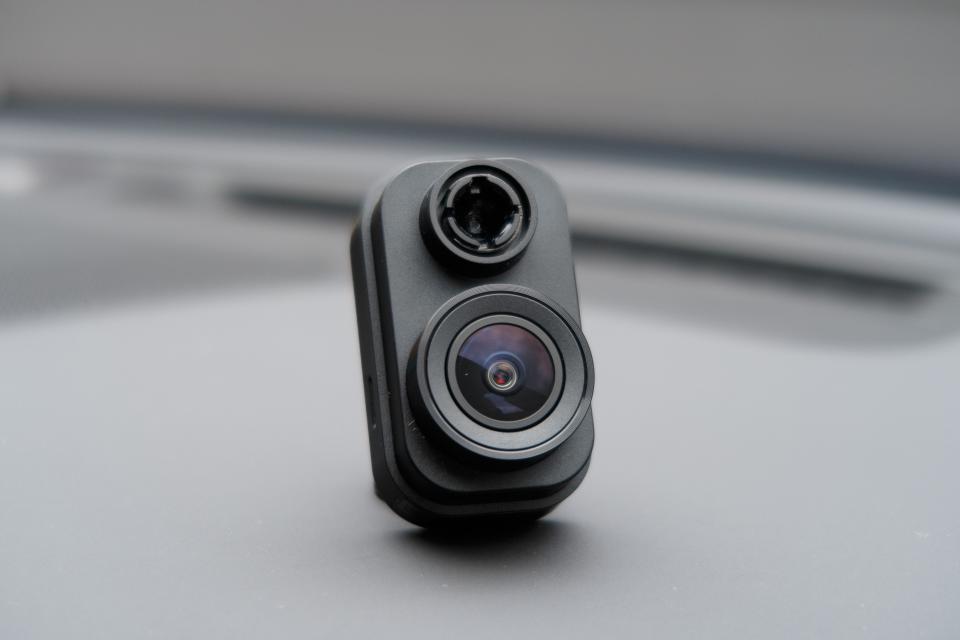
amazon.com £129.99
Gannon Burgett - Car and DriverLicense Plate at 5 (top left), 10 (top right), 25 (bottom left), 50 feet (bottom right)


Garmin Mini 2 Footage
See the original post on Youtube[12]
[embedded content]
MAXcam 360c
The MAXcam 360c primarily serves as a radar detector with a secondary dash-cam function. It isn't ideal for those seeking only a dash cam. But for anyone wanting a radar detector with a competent camera to boot, it's a great choice.
The dash cam boasts a 2560 by 1440 resolution with a Sony Starvis image sensor that captures 30 frames per second and offers a 143-degree field of view. The video quality is contrasty, with noticeable noise reduction and compression that significantly impacts image quality. We found the MAXcam 360c performed well in low-light conditions, although finer details became blurry.
It clearly captured license plates up to ten feet away under ideal conditions, but beyond that, its clarity is a miss, even in the most ideal conditions. This product isn't suitable for everyone due to its high cost and the complexity of using a radar scanner. But if you're looking for a radar detector as well as a dash cam and want to kill both birds with one stone, this Escort fits the bill.

Shop Now[13] MAXcam 360c escortradar.com
£849.95
Gannon Burgett - Car and DriverLicense Plate at 5 (top left), 10 (top right), 25 (bottom left), 50 feet (bottom right)
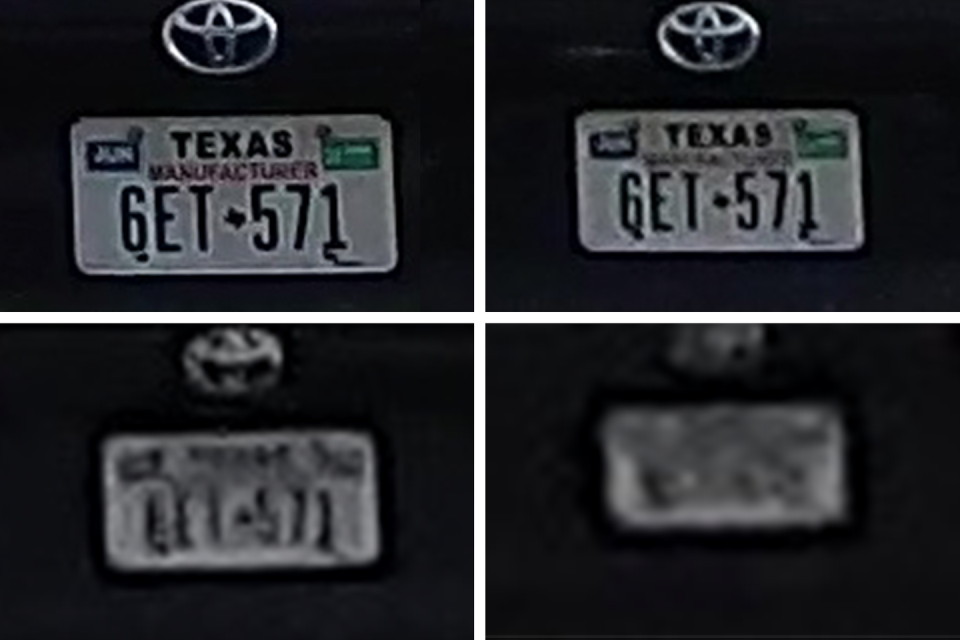

Escort MAXcam 360C Sample Footage
See the original post on Youtube[14] [embedded content]
Car Cam
If the thought of juggling micro SD cards keeps you awake at night, the Ring Car Cam might be the dash cam for you.
Powered by your vehicle's OBD-II port, the Car Cam features forward and cabin cameras. The cabin camera can be disabled easily with a physical cover, if desired. We do recommend purchasing the Ring Protect Go subscription (£6 a month/£60 a year), as it unlocks some really useful tools.
Without the subscription, the camera is fully functional, but you'll only be able to use certain functions, like live view on Wi-Fi only. Ring Protect Go unlocks LTE capability, along with other helpful perks. Videos are stored on the Car Cam's internal storage for viewing, but you'll need to upload them to the cloud for downloading privileges--which also requires the subscription.
For a full breakdown of the Ring Protect Go, check out the details here[15]. It's definitely funky and unconventional, but we like the sleek design despite its relatively imposing size. The Ring app integrates the Car Cam's footage well too.
We don't love that it uses the OBD-II port while driving, as that prevents the use of other OBD-II devices such as Progressive's Snapshot and certain GPS trackers. But for an easy footage-viewing process, the Ring Car Cam takes the cake. Ring Car Cam, Reviewed[16]
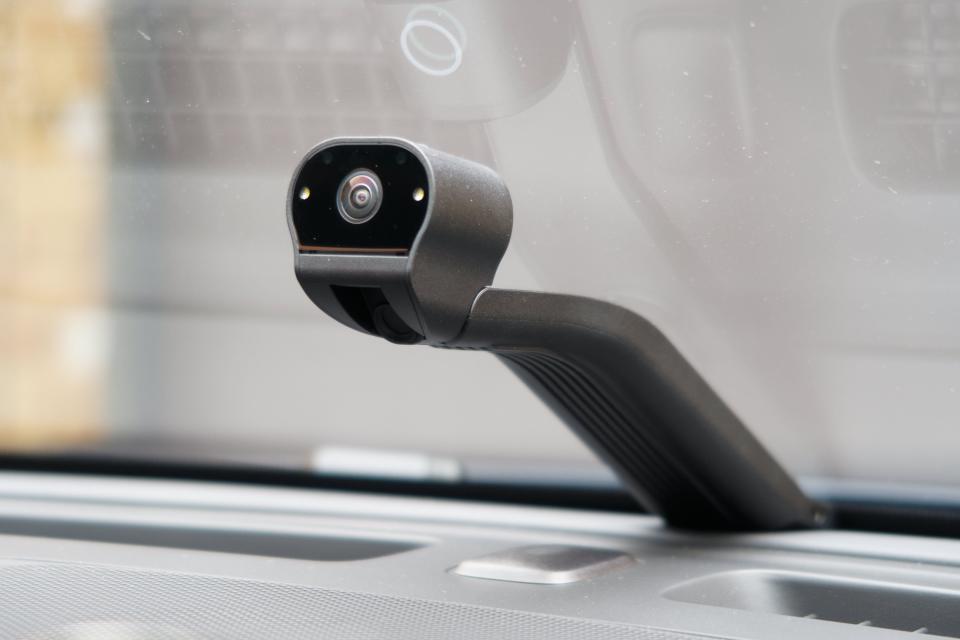
Shop Now[17] Car Cam amazon.com
£249.99
Gannon Burgett - Car and DriverLicense Plate at 5 (top left), 10 (top right), 25 (bottom left), 50 feet (bottom right)
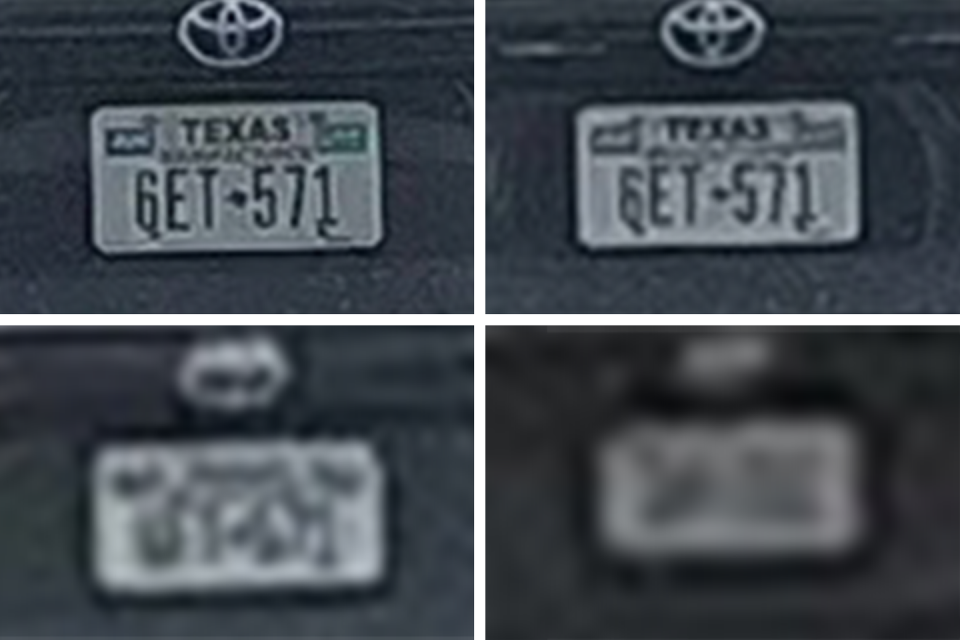

Ring Car Cam Sample Footage
See the original post on Youtube[18] [embedded content]
Beam
The Nexar Beam is an excellent entry-level dash cam.
With a reasonable price tag, it boasts the standard features you'd expect to find, like parking guardian and G-sensor collision detection, and advanced features like GPS connectivity for data overlay. Another unique option is that the app can generate an insurance incident report aligning with footage and handy GPS coordinates. Different models of the Beam come with different SD card sizes; in our case, we purchased the 32 GB option.
However, one nice feature of the Nexar is that it offers unlimited cloud storage for all G-sensor-locked data, meaning all collisions will always be stored and accessible on the cloud, which can be particularly crucial after an incident or even months after the fact.
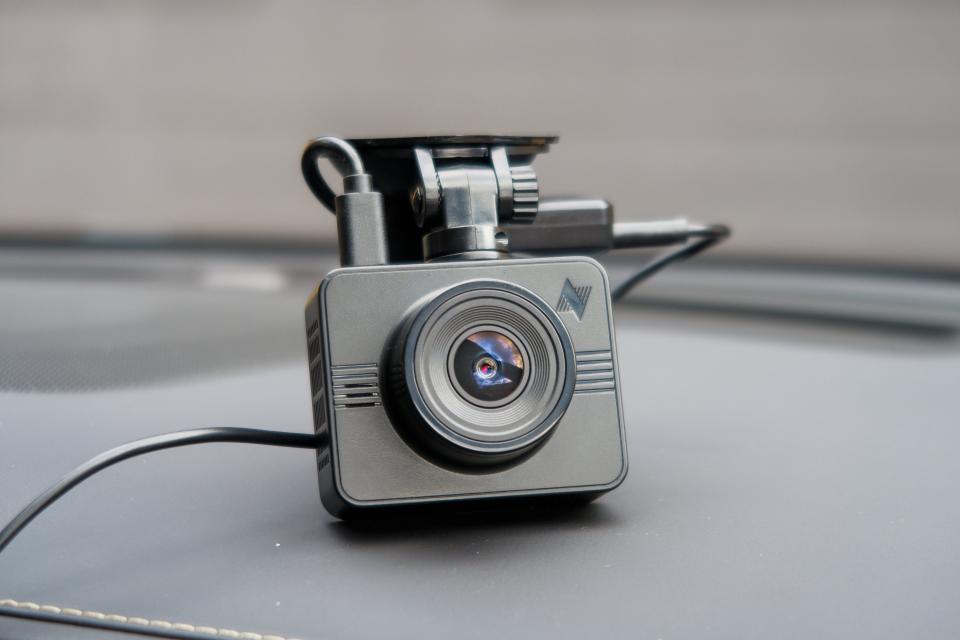
amazon.com £169.95
Gannon Burgett - Car and DriverLicense Plate at 5 (top left), 10 (top right), 25 (bottom left), 50 feet (bottom right)


Nexar Beam Sample Footage
See the original post on Youtube[20]
[embedded content]
67W
If you're looking for additional safety features, the Garmin 67W model is an excellent choice. The unit is small and unobtrusive, even compared to its Mini counterpart. To navigate through the unit's features, you utilize a series of buttons on the side of the camera instead of a touchscreen to toggle through the menus.
What we liked the most about the Garmin 67W was the integration of lane departure and forward-collision warnings, both valuable safety features missing in older vehicles. The lane departure warning was a little touchy, admittedly, but we appreciated Garmin's commitment to integrating safety features, especially for those with older-model vehicles. If you drive an older vehicle and want a modern but unobtrusive and easy-to-use dash cam, this Garmin is an excellent pick.

67W garmin.com £259.99
Gannon Burgett - Car and DriverLicense Plate at 5 (top left), 10 (top right), 25 (bottom left), 50 feet (bottom right)
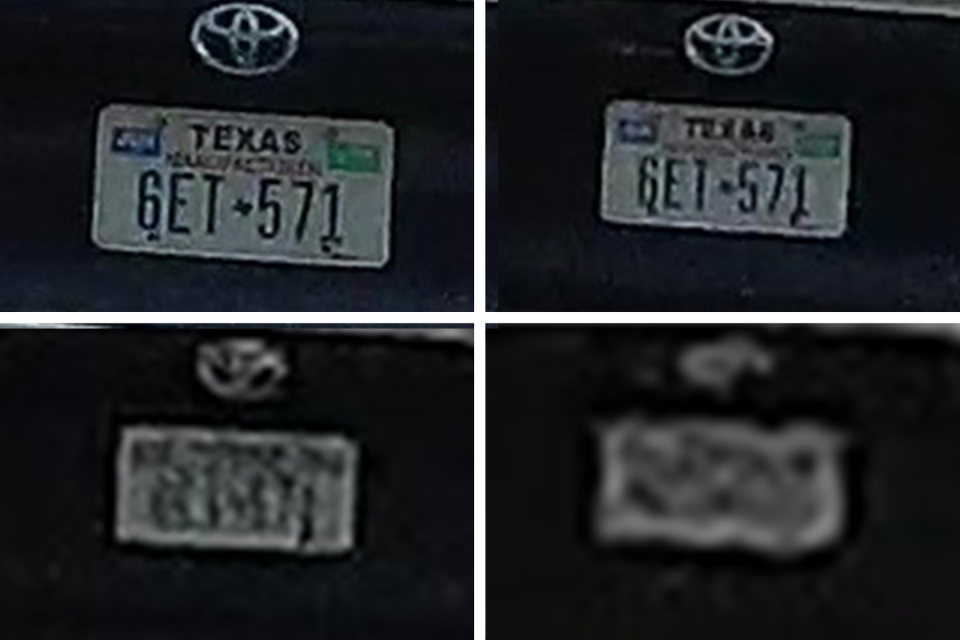
Car and Driver
Garmin 67W Footage
See the original post on Youtube[22] [embedded content]
Nextbase 322GW
Nextbase is a staple in the dash-cam world, so we had high expectations for its 322GW dash cam. Unfortunately, the unit fell far short of our expectations.
Despite its clean design, easy mounting, and large 2.5-inch touchscreen display on the rear of the camera, the unit underperformed when it came to the most important element: capturing clear high-quality video. At the core of the unit is a single camera with a 1920 by 1080 pixels (full HD) resolution and a wide, 140-degree field of view. While that should be more than enough camera to capture most daily driving without issue, our resulting image quality was more than disappointing.
The footage revealed high levels of grain during overcast and nighttime recordings and terrible dynamic range in sunny, high-contrast scenes. Together, this made it difficult to read license plates and see finer details in the footage. The camera also tended to underexpose in overcast and nighttime scenes.
The included GPS tracker (for overlaying speed data onto the footage) is a nice inclusion, and the touchscreen on the back of the camera is fantastic for composing the scene and navigating the menu. In fact, the entire user experience was solid, both directly on the device and in the accompanying Android/iOS app. Menus were simple enough to navigate, the footage was easy to review, and overall, it was one of the more comprehensive applications we tested.
Technically, the 322W gets the job done and captures at least the basic elements should you ever need footage from a traffic incident. If NextBase can step up the image quality in future models, the 322W might someday be a front-runner for our Best Overall dash cam, given how intuitive the user experience is. For now, though, we just can't rank it among our top picks due to the poor image quality we experienced.
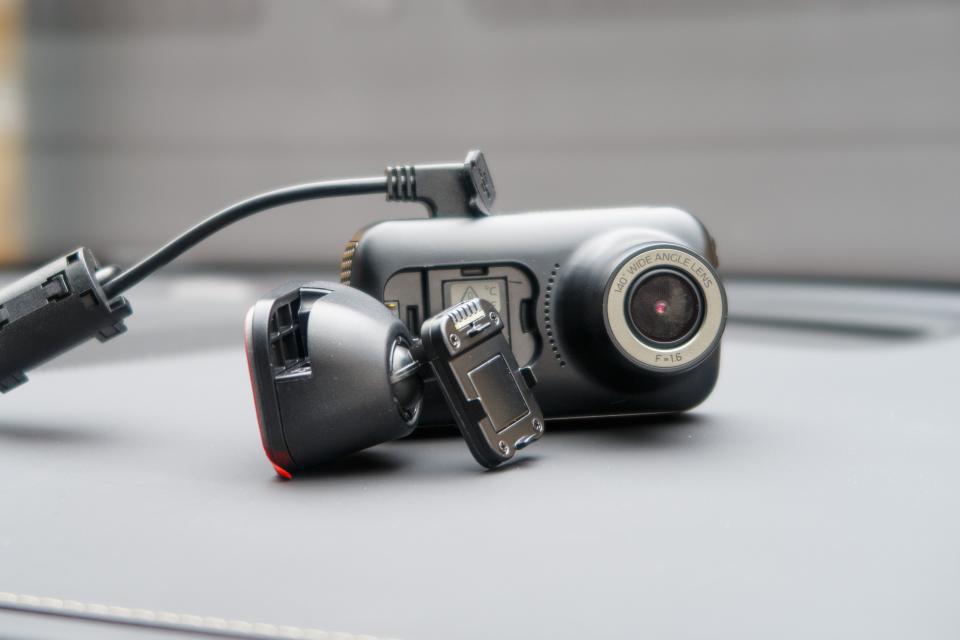
Shop Now[23] Nextbase 322GW amazon.com
£163.17
Gannon Burgett - Car and DriverLicense Plate at 5 (top left), 10 (top right), 25 (bottom left), 50 feet (bottom right)


Nextbase 322GW Sample Footage
See the original post on Youtube[24] [embedded content]
iQ 4K Smart Dash Cam Pro
The iQ is the latest dash cam from Nextbase, and it brings with it some potentially game-changing dash-cam tech.
We didn't test it directly against our other suggestions, but did want to mention it as it has some incredible features. The iQ appears to be far more than your typical dash cam, so it deserves a full product review. Keep an eye out for that.
Meanwhile, here's what we know: The iQ features specs that rival or exceed most of the best cams we've tested, with 360-degree coverage, a 2160p front cam, a 1440p interior cam, and a 1440p rear camera[25]. Where the iQ truly sets itself apart is with an array of safety features that blur the line between a dash cam and a full-suite safety system.
Lane departure, collision-imminent, and anti-sleep alerts, plus a guardian mode (for monitoring younger drivers) and a parking mode that monitors an adjustable perimeter around your vehicle are just a few of the neat tricks in the iQ's bag. The system's Roadwatch uses AI to track the speeds and locations of vehicles around you, which promises to add another layer of protection we haven't seen from any other dashboard camera. The iQ is also available in price-conscious 1k and 2K resolution versions, as well as a top-of-the-line 4K version.
We can't wait to try it out. Stay tuned for our full review.--Justin Helton

iQ 4K Smart Dash Cam Pro amazon.com £689.00
NextbaseDo You Need A Dash Cam?
While the promise of catching something amazing while driving is tantalizing, dash cams prove most valuable after a traffic incident or accident. "A dash cam records and saves road activity," Janet Ruiz, director of strategic communications at the Insurance Information Institute[27], told Car and Driver. "Video footage can provide direct evidence to law enforcement and your insurer of what caused an accident."
Bob Passmore of the American Property Casualty Insurance Association[28] agrees, noting the value of dash-cam footage in incidents like hit-and-runs, or accidents in which a person is injured (or worse) and details and information are difficult (or impossible) to come by. He also pointed out that drivers involved in traffic incidents can only supply their perspective--and, intentionally or otherwise, sometimes fudge the facts. "A dash cam doesn't lie, nor can it convince itself of a different version of events," he says. "The data tells the tale." Asked why a dash cam doesn't equate to lower auto insurance premiums, as a home or business security camera will, Passmore says it's because the value of a dash cam is only realized post-incident; it doesn't act as a deterrent to potential risk the way a security camera does.
Ruiz maintains that lower premiums can be a result of dash-cam use. While insurance companies don't usually offer discounts for dash cams, she said, they can potentially help avoid increased insurance premiums by providing evidence that a driver wasn't at fault. One law-enforcement source we spoke with claims drivers who use dash cams tend to drive more carefully. "If they know they have a dash cam in their own vehicle, people tend to operate their vehicle a little more safely," says Ralph Scianni, former police chief of Bayonne, New Jersey, with 34 years of law-enforcement experience.
Scianni told us that once dash cams became widely available to the public, the Bayonne PD saw a clear reduction in property damage and injuries as a result of vehicle accidents. "I can't see any negatives to anyone using a dash cam," he says. "[They] contribute to overall safety," Ruiz concurs, saying in an email that "drivers who install dash cams tend to pay more attention to and monitor their own driving behavior." Clearly, the use of a dash cam provides plenty of value to professional drivers such as rideshare operators and over-the-road truck drivers. Whether or not you choose to use one in your personal vehicle is up to you.
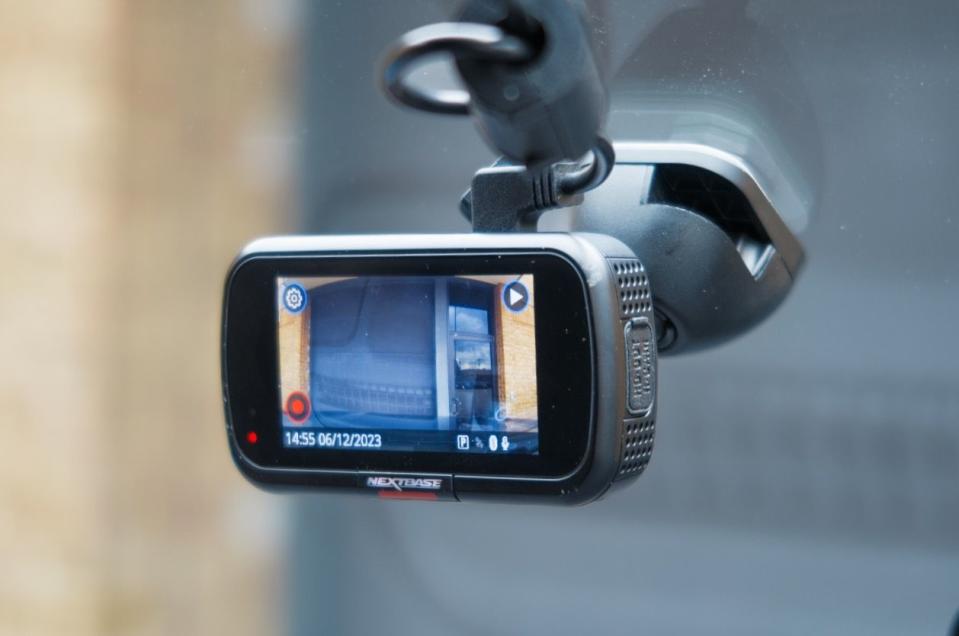
Gannon Burgett - Car and Driver
How We Tested Dash Cams
Dash cams are up against various environmental factors that impact their performance, including speed, time of day, distance, ambient light, and weather. Three days of objective testing in equal conditions allowed us to simulate various real-world scenarios, and to evaluate each dash cam's performance individually as well as comparatively. On the first day, we unboxed each dash cam, noting their reported resolution and field of view.
Additionally, we downloaded and assessed the usability of each relevant app. On the second day of testing, we took the cameras through a specified local route, first on an overcast day and then after sunset to assess the nighttime performance of each. On the final day, we evaluated clarity under sunlight by running the dash cams through the same route again on a bright, sunny day.
We also assessed license plate clarity at different distances (5, 10, 25, and 50 feet), utilizing stills pulled directly from each dash cam to determine the maximum distance at which the camera could effectively capture and record details, such as street signs and the numbers and letters on a license plate.


FAQs
How do I install a dash cam?
Most dash cams are a simple plug-and-play into your vehicle's USB or 12-volt outlet. They typically mount to the windshield or dashboard; some offer multiple mounting options.
The real challenge comes with cord management. You will likely want to run the power cord through your headliner or trim to minimize the hanging cords in your vehicle cabin. Most units come with a trim tool to help with this process.
How do I hide the dash cam's wires?
To hide the wires of your dash cam, you will need to run them behind the trim of your windshield or headliner.
Most dash-cam kits provide a simple trim tool that's designed to pull away the trim gently while you run the cord to the power source.
How much storage does my dash cam have?
It depends. Most dash cams store data locally on a micro SD card; some devices allow (or require) footage to be stored to the cloud, which often requires a subscription fee. The amount of footage a device can store depends on either the GB capacity of your micro SD card or the amount of data your cloud-storage subscription allows.
Dash cams that use memory cards often automatically overwrite the oldest data on a micro SD when the card reaches its capacity; purchase your subscription or micro SD card[29] accordingly, so vital footage isn't accidentally overwritten.
How do I know if my dash cam is recording?
Most dash cams usually have a light that flashes to indicate a recording in process. That is, however, only sometimes the case. For our test, we had to confirm our devices were recording in various ways, including looking for an indicator light or confirming via the app.
Check your user manual to confirm operation modes.
How do I retrieve footage off my dash cam?
It depends on the device. Dash-cam footage can be accessed via your micro SD card, an app, or the cloud where your camera is uploading. You will have to confirm how and where your data is saved and act accordingly.
Am I legally required to show my dash-cam footage to authorities?
Not necessarily.
Most law enforcement agencies and insurance companies will request access to your footage if they want to review it. In certain cases, you may be required to turn it over. If in doubt, consult your attorney.
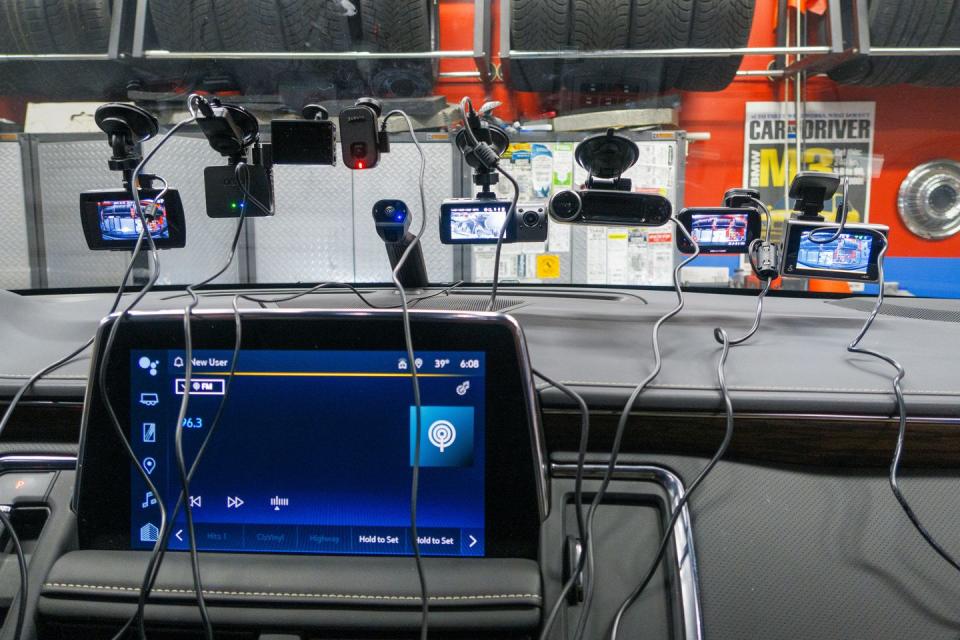
Gannon Burgett - Car and Driver
A Bit About Image Quality
Regarding image quality, you have three main components: sensor, optics, and image processing. Together, these three elements will determine how good--or bad--the video quality is from any given dash cam. First up is the sensor.
Even when talking about the sensor, though, there are two factors that determine how clear an image it can capture: the physical size and the dynamic range. Generally speaking, and all else equal, the larger the sensor physically is, the better image quality will be, particularly in low light. This is because, at any given resolution, a larger sensor means each pixel is larger.
As a result, each pixel has more area to capture photons. The next factor is dynamic range. This refers to how much range between the brightest white and darkest black the sensor can capture.
While post-processing can also impact the end result, the more dynamic range an image sensor can capture, the more information you'll have to work with when reviewing footage. This can be critical in high-contrast scenes, where you might need to see a license plate in shadow at high noon. Image sensors with low dynamic range will have a harder time showing this level of detail across the tonal range of any given scene.
The next element is optics quality. As is the case with every camera from your smartphone to a £100,000 Ferrari Hasselblad[30], the lens(es) in front of the sensor matter just as much if not more than the sensor itself. In the case of dash cams, the lenses are typically constructed of multiple individual optical elements, which are most often molded from plastic or glass (and sometimes a combination of the two for different elements in the same lens array).
Glass elements will almost always perform better than plastic elements, but they typically come with a higher production cost, which is always passed on to the consumer in one way or another. Another aspect of the lens on a dash cam is the focal length, which determines the field of view the dash cam offers. The wider the field of view, the more of the scene you'll capture in the frame.
However, you will also get more distortion, particularly at the edges of the frame. Some companies attempt to combat this through distortion correction, but any correction will impact image quality in other ways, so it's ultimately a trade-off between how much you want in the frame and how distorted you want the footage to look. As you'll see from the footage in our tests, cameras like the Garmin have expansive fields of view at the cost of very circular images that don't replicate what the human eye sees.
Meanwhile, cameras like the Escort offer a more "normal" field of view that more accurately reflects how the human eye sees the scene. The last element is image processing. No matter what dash cam you're using, the manufacturer has default settings that will determine how the data from the image sensor gets translated from raw data into a format that you can play back as a video or view as a still.
While countless variables are going on behind the scenes, noise reduction is the most significant factor that will play a role in the image quality of a dash cam. Noise reduction is applied to control the digital noise from a sensor (those colored speckles you might see in digital video at times). But applying it means details in an image can get "smeared" or blurry.
Specifically, we noticed a few camera models applied so much noise reduction that letters and numbers on license plates became almost impossible to read at certain distances, particularly in low-light scenes where noise reduction is applied more liberally during image processing. The cameras with the best image quality use just enough noise reduction to keep the digital noise at bay without creating a "watercolor effect" where details start to blend together.
Why Trust Us
Hearst Autos combines the talent, resources, and expertise of three of the largest, most influential automotive publications in the world. The Gear Team has tested a wide variety of automotive products, parts, accessories, and gear, such as backup cameras[31], portable jump starters[32], and OBD-II scanners[33].
We get our hands on each and every product we test. Most are purchased; some are supplied by manufacturers. Hearst Autos doesn't need to game algorithms for traffic or promote lousy products to earn a buck.
Instead, we're more concerned with our legacy, our reputation, and the trust that our readers have in Autoweek, Car and Driver, and Road & Track to deliver honest opinions and expert evaluations. Visit our Tested & Trusted[34] page to see the very best in automotive gear.

You Might Also Like
References
- ^ CrashDashes (www.instagram.com)
- ^ memory cards (www.amazon.com)
- ^ Garmin (www.garmin.com)
- ^ Nextbase (nextbase.com)
- ^ Shop Now (www.amazon.com)
- ^ See the original post on Youtube (www.youtube.com)
- ^ Shop Now (www.amazon.com)
- ^ See the original post on Youtube (www.youtube.com)
- ^ Shop Now (www.amazon.com)
- ^ See the original post on Youtube (www.youtube.com)
- ^ Shop Now (www.amazon.com)
- ^ See the original post on Youtube (www.youtube.com)
- ^ Shop Now (www.escortradar.com)
- ^ See the original post on Youtube (www.youtube.com)
- ^ details here (www.amazon.com)
- ^ Ring Car Cam, Reviewed (www.caranddriver.com)
- ^ Shop Now (www.amazon.com)
- ^ See the original post on Youtube (www.youtube.com)
- ^ Shop Now (www.amazon.com)
- ^ See the original post on Youtube (www.youtube.com)
- ^ Shop Now (www.garmin.com)
- ^ See the original post on Youtube (www.youtube.com)
- ^ Shop Now (www.amazon.com)
- ^ See the original post on Youtube (www.youtube.com)
- ^ 1440p rear camera (www.amazon.com)
- ^ Shop Now (www.amazon.com)
- ^ Insurance Information Institute (www.iii.org)
- ^ American Property Casualty Insurance Association (www.apci.org)
- ^ micro SD card (www.amazon.com)
- ^ £100,000 Ferrari Hasselblad (newatlas.com)
- ^ backup cameras (www.caranddriver.com)
- ^ portable jump starters (www.caranddriver.com)
- ^ OBD-II scanners (www.caranddriver.com)
- ^ Tested & Trusted (www.caranddriver.com)
- ^ here (www.caranddriver.com)
